3.2.1: Shelf-ready: Is it Worth the Money?
- Page ID
- 129452
\( \newcommand{\vecs}[1]{\overset { \scriptstyle \rightharpoonup} {\mathbf{#1}} } \) \( \newcommand{\vecd}[1]{\overset{-\!-\!\rightharpoonup}{\vphantom{a}\smash {#1}}} \)\(\newcommand{\id}{\mathrm{id}}\) \( \newcommand{\Span}{\mathrm{span}}\) \( \newcommand{\kernel}{\mathrm{null}\,}\) \( \newcommand{\range}{\mathrm{range}\,}\) \( \newcommand{\RealPart}{\mathrm{Re}}\) \( \newcommand{\ImaginaryPart}{\mathrm{Im}}\) \( \newcommand{\Argument}{\mathrm{Arg}}\) \( \newcommand{\norm}[1]{\| #1 \|}\) \( \newcommand{\inner}[2]{\langle #1, #2 \rangle}\) \( \newcommand{\Span}{\mathrm{span}}\) \(\newcommand{\id}{\mathrm{id}}\) \( \newcommand{\Span}{\mathrm{span}}\) \( \newcommand{\kernel}{\mathrm{null}\,}\) \( \newcommand{\range}{\mathrm{range}\,}\) \( \newcommand{\RealPart}{\mathrm{Re}}\) \( \newcommand{\ImaginaryPart}{\mathrm{Im}}\) \( \newcommand{\Argument}{\mathrm{Arg}}\) \( \newcommand{\norm}[1]{\| #1 \|}\) \( \newcommand{\inner}[2]{\langle #1, #2 \rangle}\) \( \newcommand{\Span}{\mathrm{span}}\)\(\newcommand{\AA}{\unicode[.8,0]{x212B}}\)
- What is shelf-ready?
- When we buy a book, it takes a lot of processing to get it to the shelf for patron use
- Shelf-ready aims to shift that processing from us to our book vendors (in this case, Yankee)
- Instead of spending our time copy cataloging, stamping, barcoding, tattle-taping and labeling books, Yankee will do all of that for us
- There are many potential benefits to shelf-ready
- The purpose of this study was two-fold:
- Can we better utilize our human resources in cataloging by switching to shelf-ready?
- Should we move all approval books to be shelf-ready?
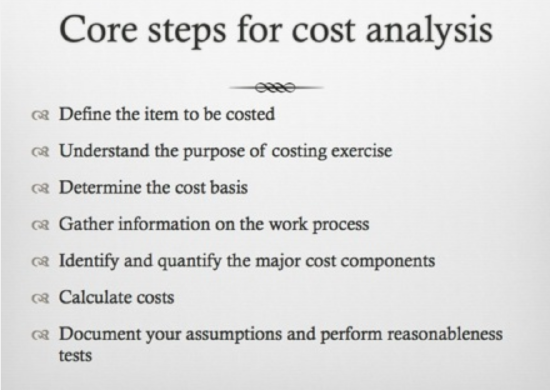
- “Define the item to be costed” - can be a product, a service, any work activity, also known as “cost objective” establishes the scope of the analysis
- Identification of cost components and the calculation of costs “other steps provide context and ensure results are accurate, explainable, repeatable, and achieve desired result”
- Understand the purpose of the costing exercise” - clarify the question cost analysis should answer and how information will be used
- “Determine the cost basis” - what data is available for the activity to be costed. Should you use actual costs or projected costs (estimates and can be based on historical data)
- “Gather information on the activity or work process” - define work involved in detail, step by step description of the work, detail how it will be performed and list resources needed to accomplish the work
- Identify and quantify the major cost components - “costs fall into one of the following categories: supplies and equipment, services, labor, or indirect costs” (Calvi 3)
- Expenses can be either direct (those clearly associated with a specific cost object) or indirect (also known as overhead) - “common to more than one cost object and are not directly traceable to a specific product” (Calvi 7)
- Supplies - “any materials that are consumed in the process of carrying out a particular activity” (Calvi 8) don’t forget to include shipping, staff time in ordering
- Equipment - “is used over and over again without being substantively consumed” (Calvi 8) “can be incorporated into a cost analysis by amortizing the expenditure over a certain time span and assigning a portion of the equipment’s cost to each item produced during that time”(Calvi 9) “total equipment cost divided by quantity of items produced during its life span = unit cost of equipment” (Calvi 10) exclude multipurpose equipment
- Service - meaning outsourcing (vendor charges + shipping, insurance, labor costs, supply and equipment costs, working with vendor, selecting, processing, packing, unpacking, performing quality control (Calvi 11)
- Labor - If staff performs only the activity being costed and productivity rates are known (divide the staff’s total compensation (salary plus benefits) by quantity of items produced during that time period. In adjusted labor rate method - workers divide their time among a variety of activities - measure time spent on an activity, multiply that time by staff’s compensation rate. To do this first define the activity listing all tasks, determine average completion time
- Calculate costs
- “Document your assumptions”
- “Perform reasonableness tests” - assess the validity of a cost analysis
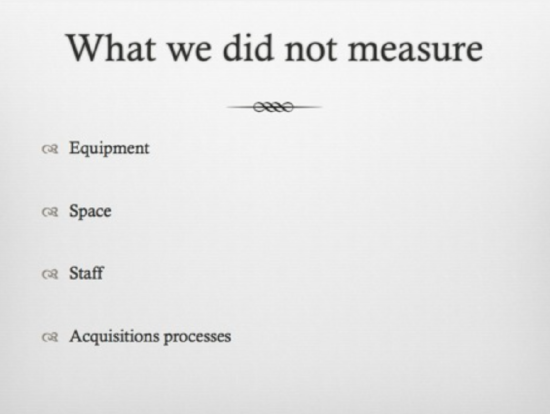
- Does not measure
- Equipment: purchase and maintenance of computers, telephones, fax machines, copiers, staplers, tape etc
- Space: cost of owning building, maintenance, heat, power, water, toilet paper, soap etc
- Staff: interviewing and hiring, training, consultation, non-productive time, mistakes, absenteeism staff development, other assignments
- Acquisitions processes: ordering (pre-order searching, order creation
- payment - invoices, statement reconciliation, processing payment, library business office, university business office
- shipment errors, returns
- retaining and maintaining records
- Integrated online system - Implementation, initial purchase cost, maintenance and ongoing costs, personnel loading records, orders, invoices.
- Processing for payment - create electronic copy in ILS, library business office, university business office cuts check, library business office verifies and mails.
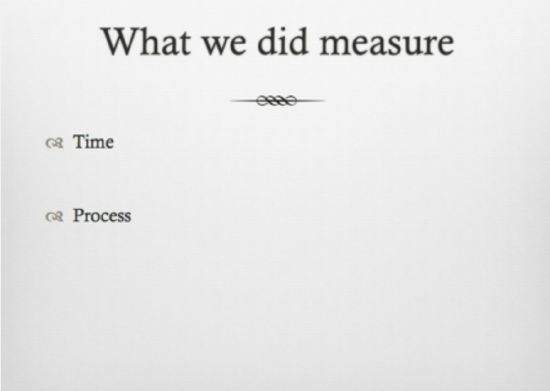
- What we did measure
- Time (from the time the box was opened until book sent to circulation to be put on shelves
- Process (followed book through its Technical Service pathway)
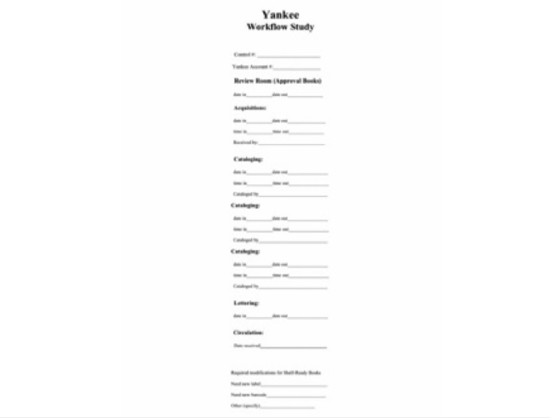
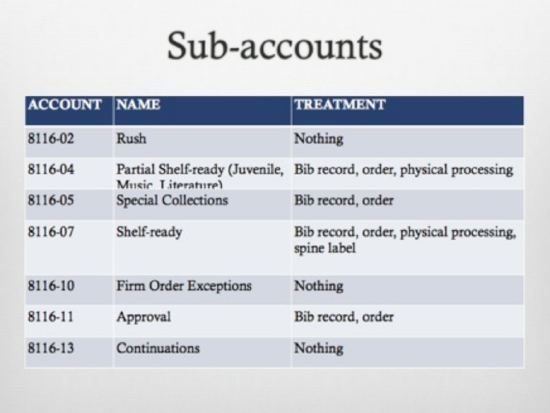
- Have 7 sub-accounts depending on the way books are sent and the level of processing
- 02-none -Rush
- 04-Bib record, order, physical processing (JUV, MUSIC, Literature (P Call #))
- 05-Bib record and order (Special Collections)
- 07-Bib record, order, physical processing, spine label (Shelf-ready)
- 10-none, exceptions another volume in set, replacement
- 11-Bib record, order, invoice (Approval)
- 13-none (continuations)
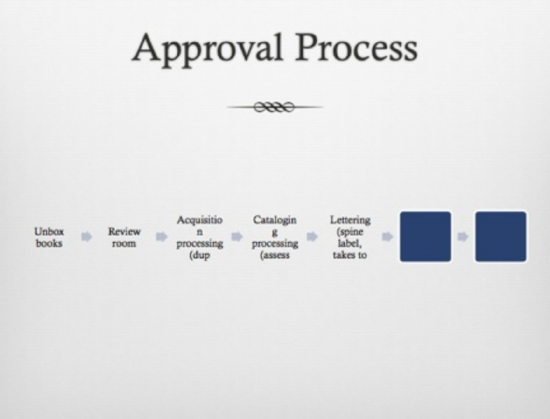
- Traditional path - Firm order, Continuations, Special Collections, Rush - these follow mostly the same path
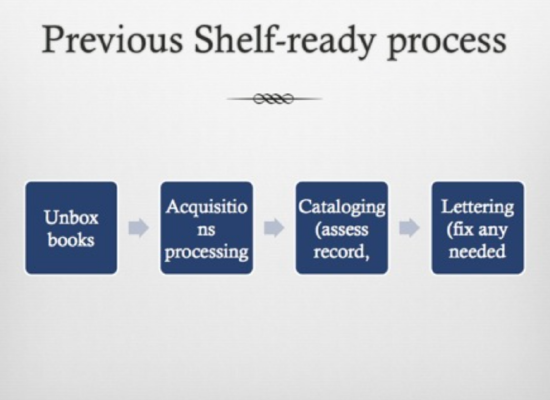
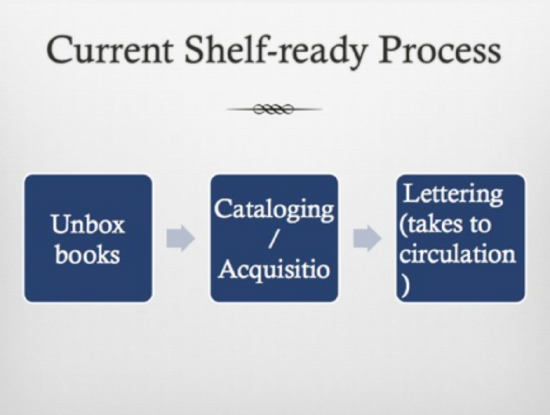
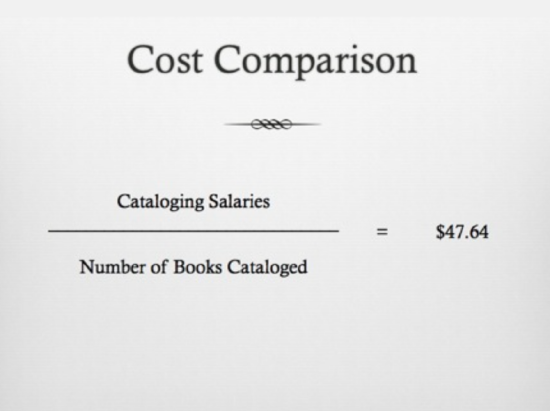
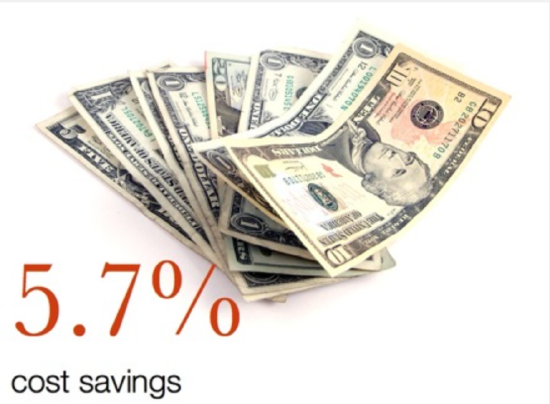
- $5.28 per book vs $5.60 per book (salary, processing, materials etc)
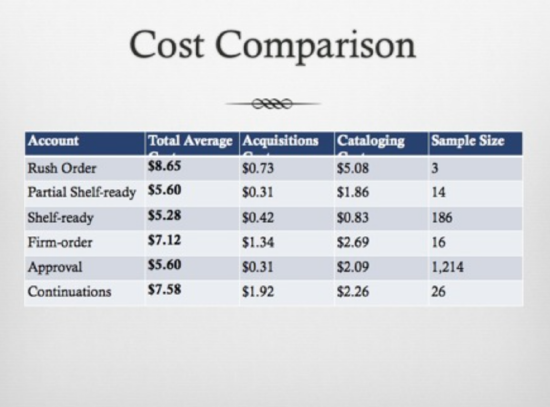
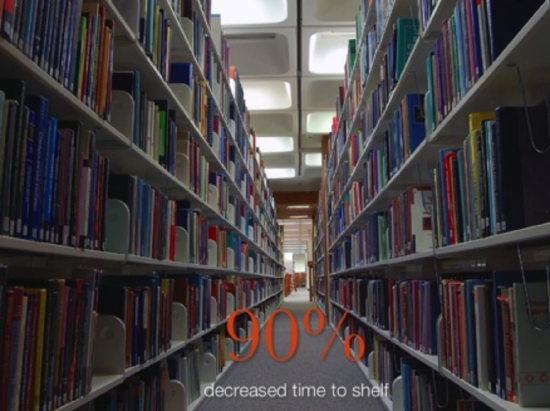
- 3.59 days per book for shelf-ready vs. 36.66 days per book for approval
- Patrons get access to books 33 days sooner
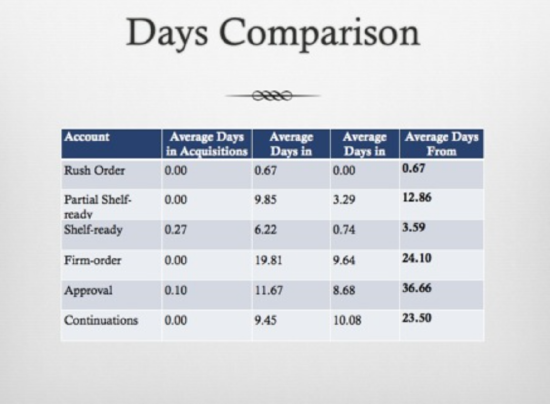
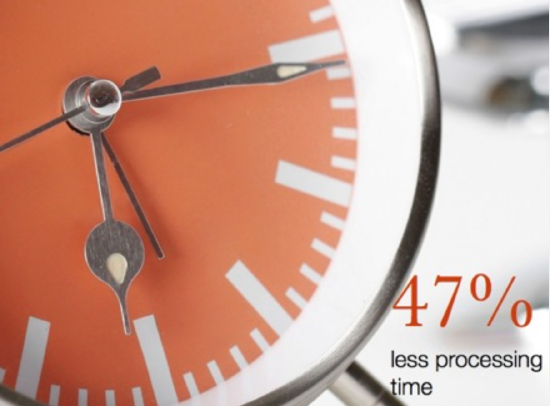
- 5:06 per book for shelf-ready vs. 9:59 per book for approval
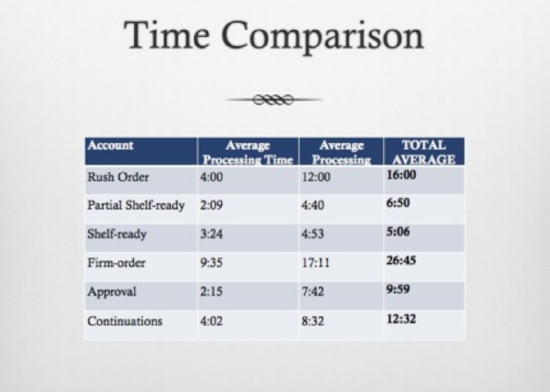
Source Information:
Shelf-ready: Is it Worth the Money?
- Jared Howland
- https://www.jaredhowland.com/presentations/shelf-ready-ula/
- No copyright information

